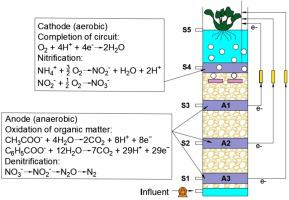Journal of Water Process Engineering ( IF 6.3 ) Pub Date : 2020-05-30 , DOI: 10.1016/j.jwpe.2020.101371 Tean-Peng Teoh , Soon-An Ong , Li-Ngee Ho , Yee-Shian Wong , Yoong-Ling Oon , Yoong-Sin Oon , Sing-Mei Tan , Wei-Eng Thung

|
The influence of floating plant (Eichhornia crassipes), supplementary aeration and circuit connection on wastewater treatment performance and electricity production using up-flow constructed wetland-microbial fuel cell (UFCW-MFC) were investigated in this study. This study was operated for four stages, where stage I was conducted without plant and aeration; stage II was planted with Eichhornia crassipes; supplementary aeration was provided in stage III; stage IV was operated in open circuit. The supplementary aeration showed the most significant effect on the performance of UFCW-MFC compared to floating plant and circuit connection. The optimum performance of wastewater treatment and electricity production was found in stage III as the oxygen was supplied by the floating plant and supplementary aeration for the degradation of organic matters as well as the generation of bioelectricity. The chemical oxygen demand (COD), NH4+ and NO3− removal efficiencies were 99 %, 96 % and 44 %, respectively. E. crassipes and supplementary aeration improved the dissolved oxygen (DO) concentration at the cathodic region and enhanced the NH4+ removal by 10 % (Stage II) and 67 % (Stage III) compared to the non-planted bioreactor (stage I). Closed circuit also performed 6 % better than open circuit at sampling point 1 (S1) in COD reduction. The maximum power density, voltage output, coulombic efficiency and normalized energy recovery were 45.46 ± 3.83 mW/m3, 291 ± 62 mV, 2.15 %, 15.09 Wh/kg COD and 0.31 W/m3, respectively.
中文翻译:

上流式湿地微生物燃料电池:浮式装置,曝气和回路连接对废水处理性能和生物发电的影响
本文研究了上浮式湿地微生物燃料电池(UFCW-MFC)对漂浮植物(凤眼兰),补充曝气和回路连接对废水处理性能和电力生产的影响。该研究进行了四个阶段,其中第一阶段是在没有植物和通风的情况下进行的。第二阶段种植凤眼莲; 第三阶段提供了补充曝气;第四阶段开路运行。与浮式设备和电路连接相比,补充曝气对UFCW-MFC的性能影响最大。在第三阶段中发现了废水处理和电力生产的最佳性能,因为氧气是由浮式设备供应的,并通过补充曝气来降解有机物以及产生生物电。化学需氧量(COD),NH 4 +和NO 3 -的去除率分别为99%,96%和44%,分别。十字花科植物和补充曝气改善了阴极区的溶解氧(DO)浓度并提高了NH4 +相比,非种植的生物反应器(第一阶段)的去除率由10%(阶段II)和67%(阶段III)。在减少COD方面,与采样点1(S1)的开路相比,闭路的性能也好6%。的最大功率密度,电压输出,库仑效率和归一化能量回收率分别为45.46±3.83毫瓦/米3,291±62毫伏,2.15%,15.09瓦时/千克COD和0.31瓦/米3,分别。











































 京公网安备 11010802027423号
京公网安备 11010802027423号